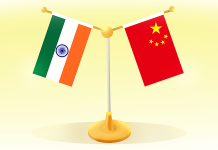On the heels of former U.S. President Donald Trump’s recent announcement of 26% reciprocal tariffs on India and several other nations, India has responded cautiously but optimistically. A senior government official has described these tariffs as a “mixed bag, not a setback,” acknowledging both the challenges and opportunities they present for India’s diverse economic landscape.
In This Article:
India’s reaction comes as the government evaluates the full impact of these tariffs, strategizing how to mitigate any negative effects while capitalizing on potential opportunities.
Key Points from India’s Response
- Economic Impact: Indian officials have outlined that the effects of the reciprocal tariffs will not be uniformly negative. Instead, they are expected to affect various industries differently, with some sectors likely to face difficulties while others remain largely unaffected.
- Mixed Outcome: While certain industries such as steel, aluminum, and textiles may see a decline in exports, India’s pharmaceuticals and information technology (IT) sectors are expected to remain largely insulated.
- Strategic Focus: The Indian government is set to monitor the situation closely and has made it clear that it will continue to engage in bilateral discussions with the U.S. to explore potential exemptions or tariff reductions on critical sectors.
Background on Trump’s Reciprocal Tariff Policy
What Are Reciprocal Tariffs?
Reciprocal tariffs, in essence, involve matching the import duties imposed by one country on the goods of another. Donald Trump’s administration has consistently advocated for such policies, viewing them as a tool for reducing the U.S. trade deficit and protecting American industries.
The latest round of tariffs primarily targets countries that, according to Trump’s assessment, have high trade surpluses with the U.S., with India and China being the most prominent nations affected.
The 26% tariff is part of a broader strategy designed to create fairer trade conditions. However, the policy has sparked mixed reactions across the globe, with many questioning its potential long-term economic effects.
Impact on India’s Key Sectors
1. Steel and Aluminum Industries
India’s steel and aluminum sectors, which contribute significantly to its export economy, are expected to be directly impacted by these tariffs. In 2023, India’s metal exports to the U.S. were valued at approximately $8 billion.
The 26% tariff increase could lead to a reduction in demand for Indian steel and aluminum, making Indian products less competitive in the U.S. market compared to those from other nations.
The Indian steel industry, in particular, has voiced concerns that these tariffs could affect jobs and reduce export revenues, potentially hampering the sector’s growth.
2. Textile and Garment Industry
India’s textile and garment sector, a major contributor to the country’s export revenue, faces a similar challenge. With the U.S. being one of the largest importers of Indian textiles, the imposition of higher tariffs on these goods could diminish price competitiveness in the American market.
As a result, Indian textile manufacturers might need to explore alternative markets or adapt their pricing strategies to maintain a foothold in the U.S.
3. Pharmaceuticals and IT Sectors: Minimal Impact
Unlike manufacturing industries, India’s pharmaceutical and IT sectors are expected to weather the storm better. The country’s generic drug exports remain in high demand, particularly in the U.S., where Indian pharma companies account for a significant share of the market.
Additionally, the IT outsourcing industry, another cornerstone of India’s economic strength, is unlikely to experience significant disruptions, given that the U.S. remains a major consumer of Indian IT services.
India’s Strategy Moving Forward
Exploring Trade Diversification
India’s immediate response to these tariffs will likely focus on trade diversification. In recent years, India has increasingly sought to expand its trade partnerships beyond the U.S. and other traditional markets. Initiatives to strengthen trade relations with ASEAN countries, the European Union, and Africa will continue to be a focal point.
Furthermore, India’s growing emphasis on “Make in India” and Production-Linked Incentive (PLI) Schemes is expected to reduce its dependency on foreign markets and promote local manufacturing. The government is focused on making the country more self-reliant, which could soften the blow from external tariffs.
Bilateral Negotiations with the U.S.
India’s government is likely to initiate diplomatic talks with the U.S., seeking exemptions or reductions in tariff rates for specific sectors. Given the strategic importance of U.S.-India relations, it is anticipated that both countries will explore ways to strike a balance that benefits both sides economically.
Global Reactions and the Broader Trade Context
India is not the only country facing the consequences of Trump’s tariffs. Several other nations, including China, Mexico, Canada, and the European Union, have also voiced concerns. Many have even initiated countermeasures, such as retaliatory tariffs or trade negotiations, in response to the unilateral tariff policies introduced by the former U.S. administration.
Moving Forward
The Indian government’s reaction to Trump’s 26% reciprocal tariffs underscores a pragmatic approach, recognizing both the challenges and opportunities these tariffs present. While sectors such as steel and textiles may face setbacks, India’s pharmaceutical and IT industries are expected to remain relatively unaffected.
The government is focused on trade diversification, enhancing domestic manufacturing, and diplomatic negotiations with the U.S. to mitigate negative consequences. India’s response reflects a strategy that balances global competitiveness with national growth priorities.
By – Nikita




